Natural heritage and landscape
Inhabited landscapes where you can accumulate moments, not things.
Hoyo de Manzanares has a natural environment that makes you fall in love. From the moment we approach it on the road, we perceive that it is not like the towns we have been leaving behind. No matter where you look, nature accompanies you and only sometimes Madrid appears in the background and reminds us that the great city is not that far away and that nevertheless, we enter a «green island»
La Sierra de Hoyo
This island mountain, with its characteristic shapes, flown over by vultures, welcomes us when entering Hoyo de Manzanares from almost anywhere. It is a protected natural area, it is private property and has one of the highest levels of protection in the Cuenca Alta del Manzanares Regional Park, therefore, we cannot and must not climb its peaks. It is not necessary, only with your profile, mark our landscape, frame our town, serve as a backdrop to our activities and a compass to our steps.
El Picazo and Peña Alonso, La Tortuga or La Mira greet us from the heights. If you want to know more about this space, we leave you a link to the blog Finca La Ladera y Los Picazos.
Within the La Ladera and Los Picazos farm, the Sierra de Hoyo Beekeeping Classroom is located.
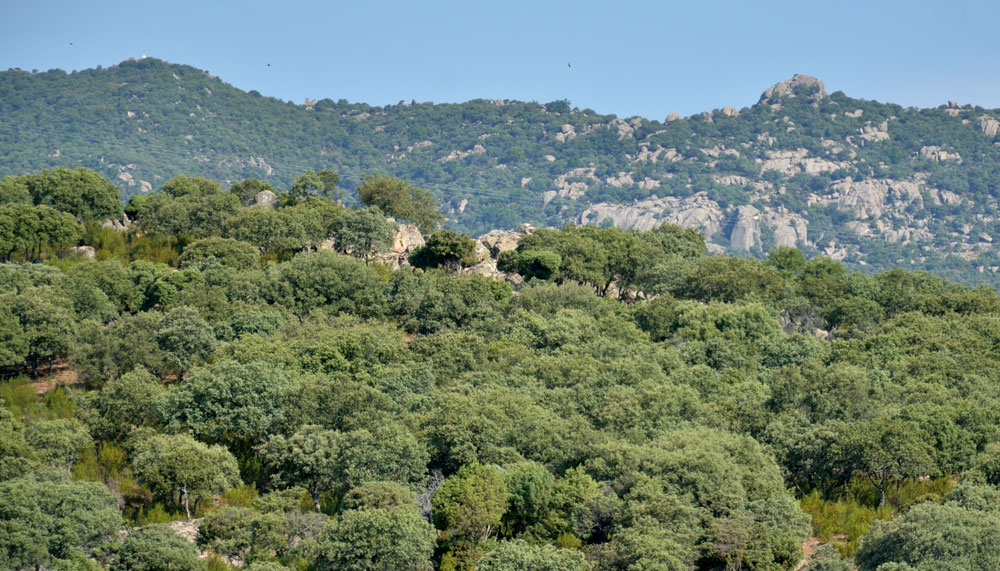
The hills
In Hoyo de Manzanares there are four unique spaces classified as Public Utility Mountains.
These mountains are public spaces endowed with special protection due to their important environmental and social benefits. They improve air quality, moderate weather conditions, are habitats for wildlife, provide products such as firewood or pastures … They are also the best places to enjoy outdoor activities.
La Cerca de La Cabilda. It is the smallest of the four Hoyo Mountains, occupying just 20 hectares, but it is possibly the most unique and without a doubt the most visited, because it is also a Recreational Area.
It is a special place, full of history. Here the remains of a Visigoth settlement have been found, the Archaeological Site of La Cabilda and possibly the place where our people were born.
Here the tradition tells that the appearance of the Patron Saint of the town also took place and it is the place where the Virgen del Rosario is brought in Pilgrimage on the first Sunday of October. Over the centuries it has not ceased to be a fundamental space in the life of Hoyo de Manzanares.
This pasture has given us stone and honey, as evidenced by the remains of an apiary hidden among the vegetation and to this day, we still provide pasture for the sheep, who sometimes carelessly graze there.
Holm oaks and junipers dominate the space, but cork oaks are the most outstanding examples. Unique, due to their size of more than 100 years, but above all, because they are the most accessible examples of some rare specimens of this species, rare in Hoyo de Manzanares, which has become acclimated to living in conditions of altitude, temperature and humidity. very far from the usual.
La Cerca de Las Viñas. The second largest mountain, it occupies a little less than 54 hectares. It is located at the foot of the Sierra de Hoyo and we can enter it through some open passages at the beginning of the Circular Route. In this space the holm oaks also coexist with some loose specimens of cork oaks, but what stands out above all are the oaks that form a small grove of great beauty.
It is the only place in Hoyo de Manzanares where we can find specimens of this species and therefore a beautiful place to walk in autumn where we can see «autumn» since most of our typical vegetation is evergreen. Here we carry out also some nature interpretation activities during our guided hiking tours for example. The variety of flora and fauna in a «reduced» space gives us a lot of play for it.
If you visit it, keep in mind that you can find cows, since being a Public Utility Mountain it maintains traditional uses and its pastures are still used for livestock. But above all, understand that it is a unique and protected space, which we want to preserve as it is. If you bring a dog, it must be leashed.
El Monte de Los Atillos. With about 122 hectares, Monte de Los Atillos is the second largest in Hoyo de Manzanares. It is located very close to the southern part of the urban area and extends unevenly on both sides of the M618 access road from Torrelodones.
It is a mountain where juniper and rockrose predominate, where lavender, thyme and other aromatics prevail that put their note of color and smell in spring. Furrowed in some sections by streams such as Trofa, La Berzosa and others of lesser importance that are marked in the landscape with a change in vegetation. At these points we find ash trees, some poplars and willows.
In these spaces, traditional activities are preserved, such as the use of pastures for cattle and goat farming, beekeeping … But above all, the hunting activity stands out, the wild boar hunt.
We take this opportunity to tell you that part of our territory is a public hunting reserve, one of the traditional uses allowed by the protection figure of the Cuenca Alta del Manzanares Regional Park. Hiking and hunting activities are perfectly compatible, however, it is essential that hunters and hikers observe the rules, so we recommend that you always use the marked public paths and that you carry your dog on a leash.
Monte Ejido. Monte Ejido, or Monte Egido, depending on the sources we can find it written with j or with g, it is a mountain of almost 160 hectares, the largest of the four. It is located to the east of the urban area, on both sides of the M618 road and more or less between the town and the Army Academy of Engineers.
When we enter from the Descansadero de la Praderuela, to the north, we are greeted by quite dense oak vegetation and if we look closely, we can even sense a cork oak among the vegetation. Along the way to the south, the vegetation opens up and changes the holm oaks for junipers, the groves shaded by the open spaces and Madrid sometimes looming in the background, on the horizon. The best point to enjoy these views is the Mirador de Monte Egido.
Like other mountains, it is also dedicated to honey, hunting and livestock uses, but in this case the traces of several livestock routes that border or cross it stand out, roads used since ancient times to lead cattle from some areas of pasture to others. depending on the season of the year.
In addition, the quarries and the use of stone that we can find on our route call our attention. Quarrying was an important activity in Hoyo de Manzanares until the mid-1960s and in 1985, with the creation of the Cuenca Alta del Manzanares Regional Park, it was completely banned. We will be welcomed by the pink granite quarry known as Juan Señora, the most visible, but there are many others in the form of veins in the ground, like the one in the photo and other vestiges of the use of stone such as the Colmenar del Sevillano, (in the limit of this Mount but visible from the road), built with stone from the Hoyo quarries and undoubtedly the best preserved of those that are distributed throughout the municipality.
Wetlands
One of the plans that we suggest you do in Hoyo de Manzanares is to visit the wetlands, in the evening, to listen to the song of the amphibians.
The enchantment of the landscape with the sunset is joined by the chorus of frogs and toads in full procession and in the background the trill of the birds. The absence of noise pollution allows you to sit there and listen to an authentic natural concert, quite a show.
Where can we see these wonders?
Wetland of the Charca de Los Camorchos
You can get there by walking from the Berzalejo Recreation Area, which is just a kilometer away. At the end of the signposted path you will find a door. This door opens just by pushing, but it gives us the clue that we are entering a specially protected natural space.
With just 1 hectare in size, it is the smallest wetland of the 23 listed in the Catalog of Reservoirs and Wetlands of the Community of Madrid and is also listed in the National Inventory of Wetlands. We have a jewel formed by small sheets of silver water where the gems that adorn them are the amphibians that inhabit them.
Here we can find different ponds, between 4 and 7 more or less depending on the amount of rainfall, in which an important variety of amphibians live.
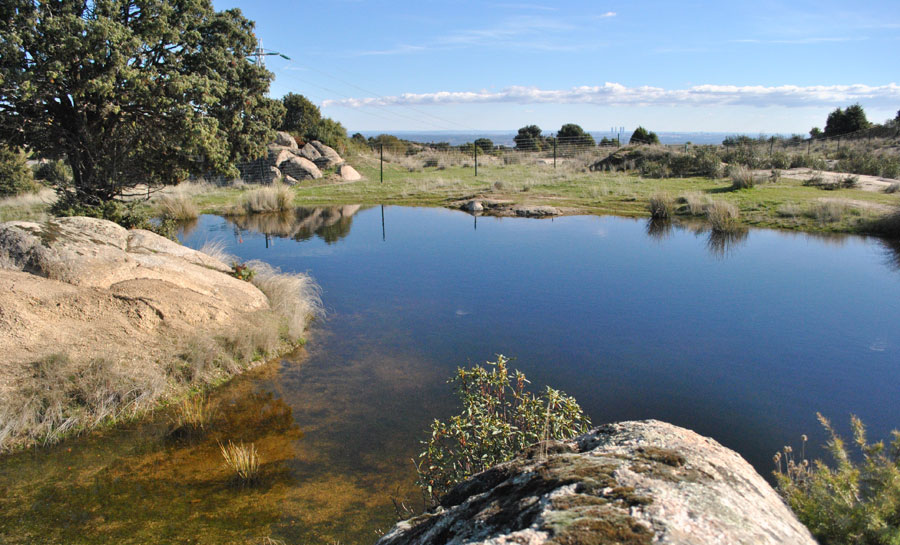
Amphibians play an important role in the ecosystem, they are predators of insects and other invertebrates so they help control pests and at the same time are prey for other animals, such as storks. They are difficult to see, so you have a panel in the lower part of the main pond that shows you the most important ones. It can also help you to get our vertebrate guide.
Thanks to environmental protection, some species that had not been seen since the 80s have been recovered. It is a very sensitive place from an environmental point of view, so it is vitally important to behave according to the rules. We cannot take amphibians from the water, or introduce exotic animals, or bathe, or let our pets do it.
And finally, a tip, silence is the best ally for this experience.
Las charcas de La Berzosa.
Another place in the municipality where you can see and hear amphibians is in the Charcas de La Berzosa, near the entrance to this urbanization from the town, behind the well-known zip line park.
Hoyo de Manzanares is an area particularly rich in amphibians due to the numerous temporary pools that form at the foot of the mountains. The most frequent species are the common toad (Bufo bufo), the runner toad (Bufo calamita), the midwife toad (Alytescisternasii) …
But without a doubt the best thing is to visit these spaces with the help of our experts. That guarantees you an unforgettable experience. Attentive to the celebration of the Day of the Wetlands (February 2) since linked to this celebration we usually organize a night out for families, sometimes, depending on how spring comes, you can also sign up for a hiking trip in which we we focus on this type of fauna.
Recreational Areas
The Recreational Areas of Hoyo de Manzanares, La Cabilda and El Berzalejo, are two very different spaces in terms of extension and landscape, but they meet the perfect conditions to spend a pleasant day in the field with family and friends.
El Berzalejo
It has numerous wooden and stone tables that on many occasions fall short of receiving visitors who come to this pleasant space. As soon as the good weather arrives, the celebrations of children’s birthday parties and meals with friends in the open air begin. It is a cool and shady space.
El Berzalejo is a repopulated pine forest in which the most striking are the twisted shapes of the pines. It is difficult to find a straight one and some, almost lying down, like the palm trees on the shore of the paradisiacal beaches, but in a rustic version, they delight the little ones.
It also has swings, a fountain and exercise equipment for adults. There´s no cafetería or shop nearby, so whatever you want to eat or drink you should buy first in Hoyo de Manzanares.
It is accessed from the M618, halfway between Torrelodones and Hoyo de Manzanares, on the left side of the road.
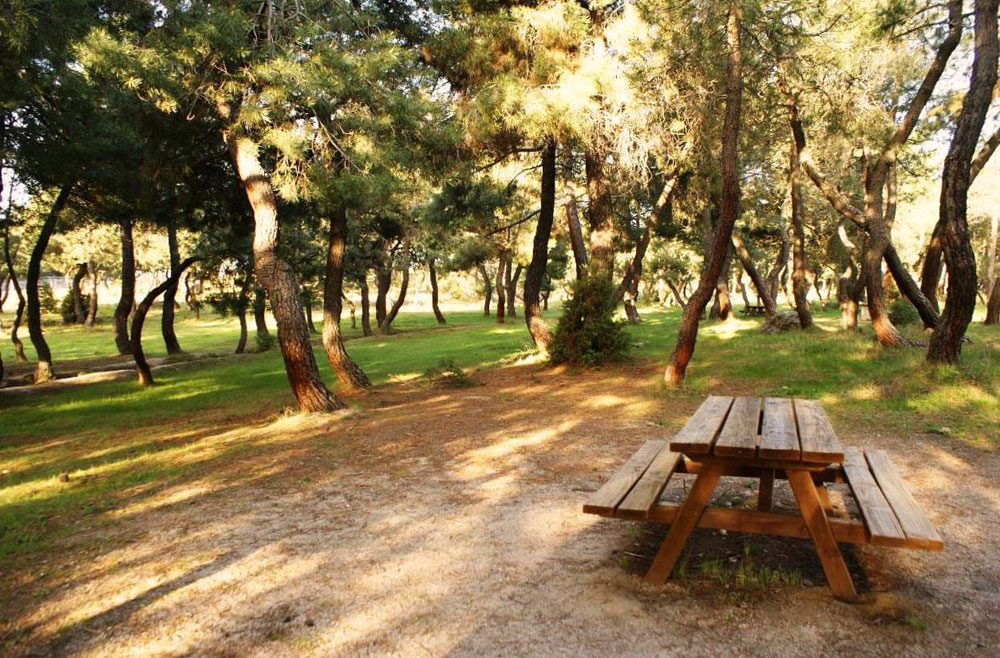
Watch out! We must respect the traffic regulations to enter and exit, going as necessary to the Las Colinas roundabout to turn around to be able to access correctly without endangering ourselves or other drivers.
As soon as we leave the road we will see a space reserved for car parking and to access the pine forest we will have to push a metal door, which serves only to delimit the space.
From here we have beautiful views of the Sierra de Hoyo and just two kilometers away is the protected Wetland of the Charca de Los Camorchos, which is a beautiful walk suitable for all ages with which to complete a perfect day.
Remember, it is important to carry garbage bags and deposit them in the outer containers to leave everything collected when you leave.
La Cabilda
It is a very unique space and very present in the life of Hoyo de Manzanares.
In this case, we will put aside its historical value and its consideration as a Mount of Public Utility and we will see it as the Recreational Area that it is. A space of almost 20 hectares that has two convenient accesses, one from the M618 road that connects Hoyo de Manzanares and Colmenar Viejo and the other, from the urban area, behind the Francisco Ayala Secondary Education Institute. In both cases we have a car park where we can leave the car and enter this space avoiding the access barriers placed to prevent road traffic.
Another option is to park your car in the town center and take a walk through the entrance of the Institute. The route from the Plaza Mayor to the entrance of La Cabilda through this point will take us just 10 minutes.
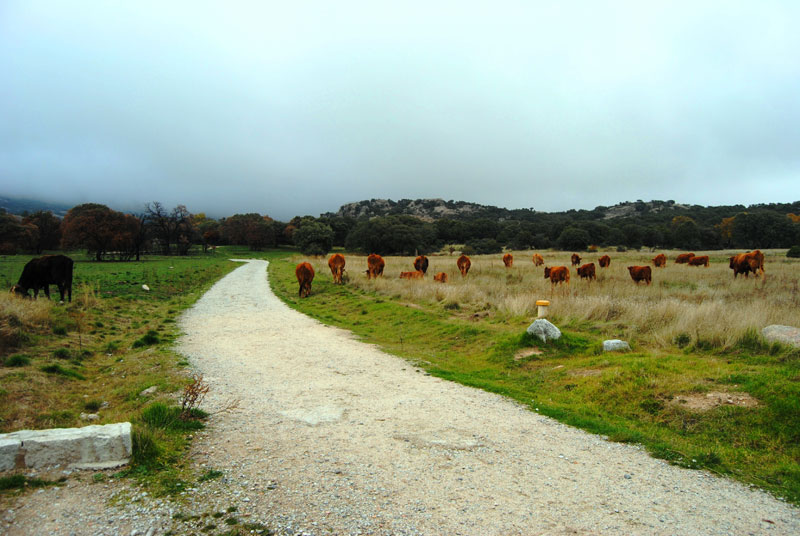
Here we have outdoor tables and benches, swings for children and two fountains. We do not have bathrooms.
But instead we do have the perfect space for children to run and play. In fact, it is a space in high demand by schools in the Community of Madrid to bring students on excursions during the week.
If you plan to come on an organized excursion, remember that in these cases it is necessary to ask the Environment department for permission.
The landscape, sheltered by the Sierra de Hoyo, with its holm oaks, junipers, ash trees and cork oaks will enchant you. Among the vegetation we find granite formations that are also characteristic of our landscape and the paths that surround it are very suitable for young children, a great way to get in touch with Nature without doing a hiking route as such.
A few meters from the main road that connects both entrances, is the Archaeological Site of La Cabilda, which we can visit on a self-guided basis any day and at any time, taking care only to leave the doors closed when leaving.
In the past there were barbecues but nowadays it is forbidden to make fires. We recommend ordering food in town, arriving early, and enjoying a full day outdoors.
It is important to carry garbage bags and deposit them in the outer containers to leave everything the same or better than you found it.
The viewpoints
The beauty of things exists in the spirit of those who contemplate them (David Hume)
The viewpoints are those places where you make a stop along the way, where you stop to enjoy the surroundings, rest and appreciate the scale of what we are in front of Nature.
La Berzosa viewpoint.
Located in the so-called Alto del Mesto, we can reach it by following the Ruta de la Cruz del Pan or going up from the parking lot on the left on the road that connects the urban area with the La Berzosa urbanization.
Here a wooden pergola with a table and two benches welcome us in front of the profile of the Sierra de Guadarrama that runs from left to right from Las Machotas to Siete Picos.
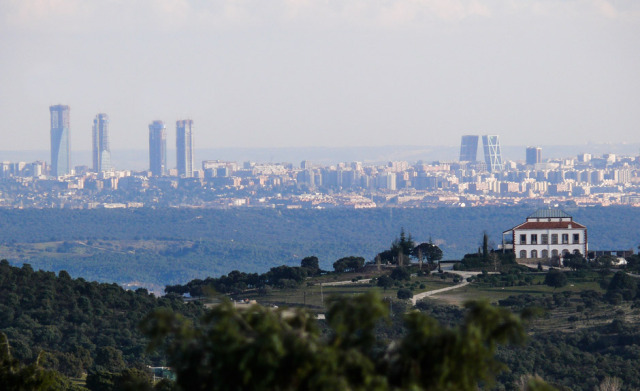
It has a landscape table in which we have named the peaks.
Monte Egido viewpoint.
On the route of the Circular Route, in the section that runs through Mount Egido, the viewpoint of the same name opens to the left of the route to invite us to see the landscape at our feet with 180-degree views. In the foreground, on the left, the sheet of water of the Pardo Reservoir shines in the distance and behind the entire skyline of the city of Madrid that reminds us that we are close, but not too much.
In front of our eyes, the landscape stretches for kilometers like a model until it comes across a relief only visible on clear days. They are the Montes de Toledo.
